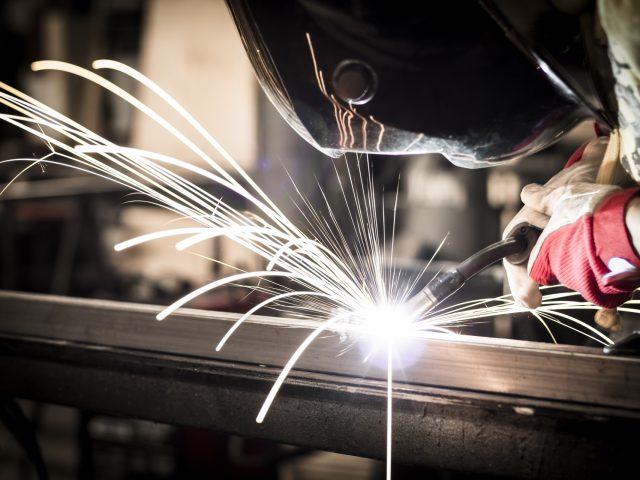Stainless steel fabrication is a process that produces pre-made parts and components from raw or stock stainless steel material. Methods of fabrication differ as much as the number of industries that rely on the process. Typically, fabrication may include one or a combination of processes that include cutting, punching, welding, forming, and machining, which itself can include various methods such as casting, stamping, bending, or rolling among others.
Advantages of Stainless Steel
As an iron-based alloy, stainless steel has many favorable properties that make it a prime choice for fabricators. It is well-known for its heat resistance, biocompatibility, strength, durability, and low maintenance. Yet, it is distinguished from other metal alloys of iron by consisting of a minimum of 10.5% chromium. The chromium content provides the formation of a tough, invisible, corrosion-resisting chromium oxide film that adheres to the steel surface. Other alloying elements found in stainless steel can vary. Depending on the application, nickel, magnesium, molybdenum, and nitrogen are just some elements frequently used.
Stainless steel is available in many different grades—300 or 400 series, for example—that are further divided into several types of families related to their metallurgical qualities. More common stainless steel family groups are austenitic, ferritic, martensitic, and duplex. Determining the grade or type of stainless steel to use for fabrication will depend on the properties desired of the application.
Common Stainless Steel Fabrication Applications
Because of its versatility, stainless steel is ideal for a wide range of metal fabrication shop projects. If there is one constant, it is an effective choice for applications where moisture—humidity, rain, snow, mist, fog, etc.—will come in contact with the product. For this reason, it is found across numerous industries. Here are 6 of the more common industries that rely on stainless steel fabrication in the manufacture of parts, components, and products.
Medical Applications
Often overlooked for its many industrial applications, stainless steel’s biocompatibility and hygienic characteristics provide the necessary properties for use in medical tools, instruments, and devices. Stainless steel grades austenitic 304 and 316 are considered surgical or medical-grade stainless steel and are used in hypodermic needles, implants, stents, and surgical devices.
Food Processing and Equipment
For similar reasons as the medical industry, stainless steel fabrication is commonly used for the manufacture of products used in food processing and related equipment. Stainless steel’s easy cleaning makes it the first choice for applications requiring strict hygienic conditions. It’s used in industrial food processing vats and tanks, refrigeration units, countertops and tables, sinks, and cookware. Cutlery and kitchenware—not only kitchen knives, spoons, and forks, but cookers, grills, and saucepans—are also made with stainless steel. Stainless steel is ideal for kitchenware because it does not absorb or interfere with the flavor of the food, it’s easy to clean, and can be kept germ free.
Energy
Because of stainless steel’s corrosion, chemical, and heat resistance, many products, and components used in the energy industry depend on stainless steel fabrication for various applications. Oil and gas platforms, pipelines, and renewable energy sources like wind turbines utilize stainless steel components. Stainless tanks, pipes, pumps, and valves are vital to the chemical, processing, and oil and gas industries. Emerging technology such as solar, hydro, geothermal, hydro, and wind power all utilize stainless steel.
Construction and Architecture
In the building and construction industry, stainless steel is used in building and architectural detail or design. Exteriors of buildings large and small are clad stainless steel. Due to its remarkable strength, its high corrosion-resistant properties, and aesthetic appeal, engineers look to stainless steel in building bridges around the world. It is also suitable for interior features such as handrails, backsplashes, countertops, and public restrooms.
Transportation
The transportation sector is greatly impacted by fabricated stainless steel products. The automotive, aerospace, rail, and marine industries all rely on stainless steel parts and components. The average passenger car alone uses about 30 to 45 pounds of stainless steel, notably in exhaust systems and for smaller parts such as hose clamps and seatbelt springs. Its been used in the fabrication of commuter trains since the 1930s, and today it is used for high-speed trains that have stainless rail transport applications. Bus bodies, too, and some tram fleets are increasingly made of stainless steel. Marine-grade stainless steel is also used in seafaring vessels—cargo tanks, piping, deck grills, housings for equipment, anchor chains, shackles, handrails, and much more are fabricated with stainless steel.
Durable Goods and Appliances
Whether in commercial kitchens and restaurants or use in a household kitchen, many different appliances are made of and depend on stainless steel fabrication. Dishwashers, refrigerators, freezers, ovens, microwave ovens, and even toasters consist of stainless steel parts and paneling. Other household appliances like washing machines are made with stainless steel, too.



